Reconstruction of June–July Temperatures Based on a 233 Year Tree-Ring of Picea jezoensis var. microsperma
Abstract
1. Introduction
2. Materials and Methods
2.1. Study Area and Sample Collection
2.2. Development of Ring-Width Chronologies
2.3. Climate Data
2.4. Statistical Methods
3. Results
3.1. Chronology Statistics
3.2. Growth/Climate Responses
3.3. Maximum Temperature Reconstruction
3.4. Temperature Variability from AD 1772 to 2004
3.5. The Result of Periodicity Analyses
4. Discussion
4.1. Physiological Significance of June–July Maximum Temperature
4.2. Temperature–Rainfall Relationships and Comparision with Historical Document Records in Jilin Province
4.3. Regional- to Large-Scale Comparison
4.4. Periodicities and Possible Climate Drivers
5. Conclusions
Supplementary Materials
Author Contributions
Funding
Conflicts of Interest
References
- Intergovernmental Panel on Climate Change. Climate Change 2014: Mitigation of Climate Change; Cambridge University Press: Cambridge, UK, 2014. [Google Scholar]
- Chen, P.Y.; Welsh, C.; Hamann, A. Geographic variation in growth response of Douglas-fir to interannual climate variability and projected climate change. Glob. Chang. Biol. 2010, 16, 3374–3385. [Google Scholar] [CrossRef]
- Huang, J.; Tardif, J.C.; Bergeron, Y.; Denneler, B.; Berninger, F.; Girardin, M. Radial growth response of four dominant boreal tree species to climate along a latitudinal gradient in the eastern Canadian boreal forest. Glob. Chang. Biol. 2010, 16, 711–731. [Google Scholar] [CrossRef]
- Crimmins, S.M.; Dobrowski, S.Z.; Greenberg, J.A. Changes in climatic water balance drive downhill shifts in plant species’ optimum elevations. Science 2011, 331, 177. [Google Scholar] [CrossRef]
- Jiang, Y.G.; Zhang, J.H.; Han, S.J.; Chen, Z.J.; Setälä, H.; Yu, J.H. Radial Growth Response of Larix gmelinii to Climate along a Latitudinal Gradient in the Greater Khingan Mountains, Northeastern China. Forests 2016, 7, 295. [Google Scholar] [CrossRef]
- Zhang, X.; Bai, X.; Chang, Y.; Chen, Z. Increased sensitivity of Dahurian larch radial growth to summer temperature with the rapid warming in Northeast China. Trees 2016, 30, 1799–1806. [Google Scholar] [CrossRef]
- Liang, J.; Xia, J.; Liu, L.; Wan, S.Q. Global patterns of the responses of leaf-level photosynthesis and respiration in terrestrial plants to experimental warming. J. Plant Ecol. 2013, 6, 437–447. [Google Scholar] [CrossRef]
- Lin, D.; Xia, J.; Wan, X.S. Climate warming and biomass accumulation of terrestrial plants: A meta-analysis. New Phytol. 2010, 188, 187–198. [Google Scholar] [CrossRef] [PubMed]
- Peng, J.; Peng, K.; Li, J. Climate-growth response of Chinese white pine (Pinus armandii) at different age groups in the Baiyunshan National Nature Reserve, central China. Dendrochronologia 2018, 49, 102–109. [Google Scholar] [CrossRef]
- Xie, J.; Chen, J.; Sun, G.; Chu, H.; Noormets, A.; Ouyang, Z.; John, R.; Wan, S.; Guan, W. Long-term variability and environmental control of the carbon cycle in an oak-dominated temperate forest. For. Ecol. Manag. 2014, 313, 319–328. [Google Scholar] [CrossRef]
- Ding, Y.H.; Dai, X.S. Temperature variation in China during the last 100 years. Meteorol. Mon. 1994, 12, 19–26. (In Chinese) [Google Scholar]
- Wang, L.; Wu, Z.; He, H.; Wang, F.; Du, H.; Zong, S. Changes in summer extreme precipitation in Northeast Asia and their relationships with the East Asian summer monsoon during 1961–2009. Int. J. Climatol. 2016, 37, 25–35. [Google Scholar] [CrossRef]
- Sun, L.; Shen, B.; Sui, B. The influences of East Asian Monsoon on summer precipitation in Northeast China. Clim. Dyn. 2017, 48, 1647–1659. [Google Scholar] [CrossRef]
- Liu, Y.; Zhang, X.; Song, H.; Cai, Q.; Li, Q.; Zhao, B. Tree-ring-width-based PDSI reconstruction for central Inner Mongolia, China over the past 333 years. Clim. Dyn. 2016, 48, 867–879. [Google Scholar] [CrossRef]
- Wang, Y.; Liu, Y. Reconstruction of March–June precipitation from tree rings in central Liaoning, China. Clim. Dyn. 2016, 49, 1–11. [Google Scholar] [CrossRef]
- Lean, J.; Rind, D. Evaluating sun–climate relationships since the Little Ice Age. J. Atmos. Sol.-Terr. Phys. 1999, 61, 25–36. [Google Scholar] [CrossRef]
- Bond, G.; Kromer, B.; Beer, J.; Muscheler, R.; Evans, M.N.; Showers, W.; Hoffmann, S.; Lotti-Bond, R.; Hajdas, I.; Bonani, G. Persistent Solar Influence on North Atlantic Climate During the Holocene. Science 2001, 294, 2130–2136. [Google Scholar] [CrossRef] [PubMed]
- Velasco Herrera, V.M.; Mendoza, B.; Herrera, G.V. Estimating Total Solar Irradiance Composites (ACRIM and PMOD): From the Medieval Warm Period to the 21st century. Can. J. Chem. 2011, 58, 1892–1893. [Google Scholar]
- Velasco Herrera, V.M.; Mendoza, B.; Herrera, G.V. Reconstruction and prediction of the total solar irradiance: From the Medieval Warm Period to the 21st century. New Astron. 2015, 34, 221–233. [Google Scholar] [CrossRef]
- Wang, Z.; Ding, Y.; He, J.; Yu, J. An updating analysis of the climate change in China in recent 50 years. Acta Meteorol. Sin. 2004, 62, 228–236. (In Chinese) [Google Scholar]
- Esper, J.; Cook, E.R.; Schweingruber, F.H. Low-frequency signals in long tree-ring chronologies for reconstructing past temperature variability. Science 2002, 295, 2250–2253. [Google Scholar] [CrossRef] [PubMed]
- Zhang, Q.; Cheng, G.; Yao, T. A 2,326-year tree-ring record of climate variability on the northeastern Qinghai-Tibetan Plateau. Geophys. Res. Lett. 2003, 30. [Google Scholar] [CrossRef]
- Fritts, H.C. Tree Rings and Climate; Academic Press: New York, NY, USA, 1976. [Google Scholar]
- Mann, M.E.; Zhang, Z.; Rutherford, S. Global signatures and dynamical origins of the Little Ice Age and Medieval Climate Anomaly. Science 2009, 326, 1256. [Google Scholar] [CrossRef]
- Cook, E.R.; Anchukaitis, K.J.; Buckley, B.M. Asian monsoon failure and megadrought during the last millennium. Science 2010, 328, 486–489. [Google Scholar] [CrossRef]
- Davi, N.; Jacoby, G.; Fang, K. Reconstructing drought variability for Mongolia based on a large-scale tree ring network: 1520–1993. J. Geophys. Res. Atmos. 2010, 115, 1842–1851. [Google Scholar] [CrossRef]
- Bao, G.; Liu, Y.; Linderholm, H.W. April–September mean maximum temperature inferred from Hailar pine (Pinus sylvestris var. mongolica) tree rings in the Hulunbuir region, Inner Mongolia, back to 1868 AD. Palaeogeogr. Palaeoclimatol. Palaeoecol. 2012, 313, 162–172. [Google Scholar] [CrossRef]
- Wang, Y.; Liu, Y.; Zhang, H.; Wang, H.; Guo, J. Temperature variability inferred from tree-ring records in Weichang region, China, and its teleconnection with large-scale climate forcing. Clim. Dynam. 2019, 50, 2157–2168. [Google Scholar] [CrossRef]
- Yu, D.; Liu, J.; Lewis, B.J. Spatial variation and temporal instability in the climate–growth relationship of Korean pine in the Changbai Mountain region of Northeast China. For. Ecol. Manag. 2013, 300, 96–105. [Google Scholar] [CrossRef]
- Chen, L.; Wu, S.; Pan, T. Variability of climate–growth relationships along an elevation gradient in the Changbai Mountain, northeastern China. Trees 2011, 25, 1133–1139. [Google Scholar] [CrossRef]
- Wang, H.; Shao, X.M.; Jiang, Y. The impacts of climate change on the radial growth of Pinus koraiensis along elevations of Changbai Mountain in northeastern China. For. Ecol. Manag. 2013, 289, 333–340. [Google Scholar] [CrossRef]
- Shao, X.; Wu, X. Reconstruction of climate change on Changbai Mountain, Northeast China using tree-ring data. Quat. Sci. 1997, 1, 76–83. (In Chinese) [Google Scholar]
- Zhu, H.F.; Fang, X.Q.; Shao, X.M.; Yin, Z. Tree ring-based February–April temperature reconstruction for Changbai Mountain in Northeast China and its implication for East Asian winter monsoon. Clim. Past Discuss. 2009, 5, 661–666. [Google Scholar] [CrossRef]
- Editorial Committee for Forestry of Jilin. Forest of Jilin; China Forestry Press: Beijing, China, 1988. (In Chinese) [Google Scholar]
- Wang, W.W.; Zhang, J.H.; Dai, G.H. Tree-ring based temperature variability in autumn over the past 240 years in Changbai Mountain. Chin. J. Ecol. 2012, 31, 787–793. (In Chinese) [Google Scholar]
- Lyu, S.; Li, Z.; Zhang, Y. A 414-year tree-ring-based April–July minimum temperature reconstruction and its implications for the extreme climate events, northeast China. Clim. Past. 2016, 12, 1879–1888. [Google Scholar] [CrossRef]
- Cook, E.R. Methods of Dendrochronology: Applications in Environmental Science; Springer Science & Business Media: Berlin, Germany, 1990. [Google Scholar]
- Holmes, R.L. Computer-Assisted Quality Control in Tree-Ring Dating and Measurement. Tree-Ring Bull. 1983, 44, 69–75. [Google Scholar]
- Wigley, T.M.L.; Briffa, K.R.; Jones, P.D. On the Average Value of Correlated Time Series, with Applications in Dendroclimatology and Hydrometeorology. J. Climatol. Appl. Meteorol. 1984, 23, 201–213. [Google Scholar] [CrossRef]
- Kendall, M.; Gibbons, J.D. Rank Correlation Methods, 5th ed.; Arnold: London, UK, 1990. [Google Scholar]
- Fu, C.B.; Wang, Q. The definition and detection of the abrupt climatic change. Sci. Atmos. Sin. 1992, 16, 482–493, (In Chinese, with English abstract). [Google Scholar]
- Blasing, T.J.; Solomon, A.M.; Duvick, D.N. Response functions revisited. J. Chem. Phys. 1984, 44, 1–15. [Google Scholar]
- Biondi, F.; Waikul, K. DENDROCLIM2002: A C++ program for statistical calibration of climate signals in tree-ring chronologies. Comput. Geosci. 2004, 30, 303–311. [Google Scholar] [CrossRef]
- Meko, D.M.; Graybill, D.A. Tree-ring reconstruction of upper Gila River discharge. Water Res. Bull. 1995, 31, 605–616. [Google Scholar] [CrossRef]
- Mann, M.E.; Lees, J.M. Robust estimation of background noise and signal detection in climatic time series. Clim. Chang. 1996, 33, 409–445. [Google Scholar] [CrossRef]
- Wen, K.G. China Meteorological Disaster in Jilin Province; China Meteorological Press: Beijing, China, 2008. (In Chinese) [Google Scholar]
- Zhang, T.; Yuan, Y.; Wei, W.; Yu, S.; Zhang, R.; Shang, H.; Chen, F.; Fan, Z.; Qin, L. Tree-ring-based temperature reconstruction for the northern Greater Higgnan Mountains, China, since A.D. 1717. Int. J. Climatol. 2013, 33, 422–429. [Google Scholar] [CrossRef]
- Ma, Y.; Liu, Y.; Song, H. A Standardized Precipitation Evapotranspiration Index Reconstruction in the Taihe Mountains Using Tree-Ring Widths for the Last 283 Years. PLoS ONE 2015, 10, e0133605. [Google Scholar] [CrossRef]
- Dulamsuren, C.; Khishigjargal, M.; Leuschner, C. Response of tree-ring width to climate warming and selective logging in larch forests of the Mongolian Altai. J. Plant Ecol. 2014, 7, 24–38. [Google Scholar] [CrossRef]
- Liu, H.; Park, W.A.; Allen, C.D. Rapid warming accelerates tree growth decline in semi-arid forests of Inner Asia. Glob. Chang. Biol. 2013, 119, 2500–2510. [Google Scholar] [CrossRef] [PubMed]
- Yi, L.; Yu, H.; Ge, J.; Lai, Z.; Xu, X.; Qin, L.; Peng, S. Reconstructions of annual summer precipitation and temperature in north-central China since 1470 AD based on drought/flood index and tree-ring records. Clim. Chang. 2012, 110, 469–498. [Google Scholar] [CrossRef]
- Wen, K.G. China Meteorological Disaster in Heilongjiang Province; China Meteorological Press: Beijing, China, 2007. (In Chinese) [Google Scholar]
- Beer, J.; Mende, W.; Stellmacher, R. The role of the sun in climatic forcing. Quat. Sci. Rev. 2000, 19, 403–415. [Google Scholar] [CrossRef]
- Yin, H.; Guo, P.; Liu, H.; Huang, L.; Yu, H.; Guo, S.; Wang, F. Reconstruction of the October mean temperature since 1796 at Wuying from tree ring data. Adv. Clim. Chang. Res. 2009, 5, 18–23. [Google Scholar]
- Wang, W.; Zhang, J.; Dai, G.; Wang, X.; Han, S.; Zhang, H.; Wang, Y. Variation of autumn temperature over the past 240 years in Changbai Mountain of Northeast China: A reconstruction with tree-ring records, China. J. Ecol. 2012, 31, 787–793. [Google Scholar]
- Zhu, L.; Li, S.; Wang, X. Tree-ring reconstruction of February-March mean minimum temperature back to 1790 AD in Yichun, Northeast China. Quat. Sci. 2015, 35, 1175–1184. [Google Scholar]
- Wei, F.Y. Modern Climate Statistics Diagnosis and Forecasting Techniques; China Meteorological Press: Beijing, China, 2010. (In Chinese) [Google Scholar]
- Su, M.F.; Wang, H.J. Relationship and its instability of ENSO—Chinese variations in droughts and wet spells. Sci. China Ser. D 2007, 50, 145–152. [Google Scholar] [CrossRef]
- Hocke, K. QBO in solar wind speed and its relation to ENSO. J. Atmos. Sol.-Terr. Phys. 2009, 71, 216–220. [Google Scholar] [CrossRef]
- Gergis, J.L.; Fowler, A.M. A history of ENSO events since A.D. 1525: Implications for future climate change. Clim. Chang. 2009, 92, 343–387. [Google Scholar] [CrossRef]
- Chen, Z.; Zhang, X.; Cui, M. Tree-ring based precipitation reconstruction for the forest–steppe ecotone in northern Inner Mongolia, China and its linkages to the Pacific Ocean variability. Glob. Planet. Chang. 2012, 86–87, 45–56. [Google Scholar] [CrossRef]
- Yang, G.; Chen, X.; Zhou, D. Ordination and gradient analysis of coniferous forest in Daxinganling. J. Northeas. For. Univ. 1992, 3, 42–47. [Google Scholar]
- Li, J.; Zeng, Q. A new monsoon index and the geographical distribution of the global monsoons. Adv. Atmos. Sci. 2003, 20, 299–302. [Google Scholar]
- Zhang, R.H.; Sumi, A.; Kimoto, M. A diagnostic study of the impact of El Niño on the precipitation in China. Adv. Atmos. Sci. 1999, 16, 229–241. [Google Scholar] [CrossRef]
- Wu, R.; Wang, B.A. Contrast of the East Asian Summer Monsoon-ENSO Relationship between 1962–1977 and 1978–1993. J. Clim. 2002, 15, 3266–3279. [Google Scholar] [CrossRef]
- Lu, R.Y. Interannual variation of North China rainfall in rainy season and SSTs in the equatorial eastern Pacific. Chin. Sci. Bull. 2005, 50, 2069–2073. [Google Scholar] [CrossRef]
- Li, J.; Cook, E.R.; D’Arrigo, R. Moisture variability across China and Mongolia: 1951–2005. Clim. Dynam. 2009, 32, 1173–1186. [Google Scholar] [CrossRef]
- Gao, J.; Shi, Z.; Xu, L. Precipitation variability in Hulunbuir, northeastern China since 1829 AD reconstructed from tree-rings and its linkage with remote oceans. J. Arid Environ. 2013, 95, 14–21. [Google Scholar] [CrossRef]
- Grootes, P.M.; Stuiver, M. Oxygen 18/16 variability in Greenland snow and ice with 103 to 105-year time resolution. J. Geophys. Res. 1997, 102, 26455–26470. [Google Scholar] [CrossRef]
- Nagovitsyn, Y.A. Solar activity during the last two millennia: Solar patrol in ancient and medieval China. Geomagn. Aeron. 2001, 41, 680–688. [Google Scholar]
- Ogurtsov, M.G.; Nagovitsyn, Y.A.; Kocharov, G.E.; Jungner, H. Long-period cycles of the Sun’s activity recorded in direct solar data and proxies. Sol. Phys. 2002, 211, 371–394. [Google Scholar] [CrossRef]
- Auer, G.; Piller, W.E.; Harzhauser, M. Two distinct decadal and centennial cyclicities forced marine upwelling intensity and precipitation during the late Early Miocene in central Europe. Clim. Past Discuss. 2015, 10, 1223–1264. [Google Scholar] [CrossRef]
- Minobe, S. Resonance in bidecadal and pentadecadal climate oscillations over the North Pacific: Role in climatic regime shifts. Geophys. Res. Lett. 1999, 26, 855–858. [Google Scholar] [CrossRef]
- Gedalof, Z.; Mantua, N.J.; Peterson, D.L. A multi-century perspective of variability in the Pacific Decadal Oscillation: New insights from tree rings and coral. Geophys. Res. Lett. 2002, 29, 57-1–57-4. [Google Scholar] [CrossRef]
- Ma, Z.G. The interdecadal trend and shift of dry/wet over the central part of north China and their relationship to the Pacific Decadal Oscillation (PDO). Chin. Sci. Bull. 2007, 52, 2130–2139. [Google Scholar] [CrossRef]
- MacDonald, G.M.; Case, R.A. Variations in the Pacific Decadal Oscillation over the past millennium. Geophys. Res. Lett. 2005, 32, L08703. [Google Scholar] [CrossRef]
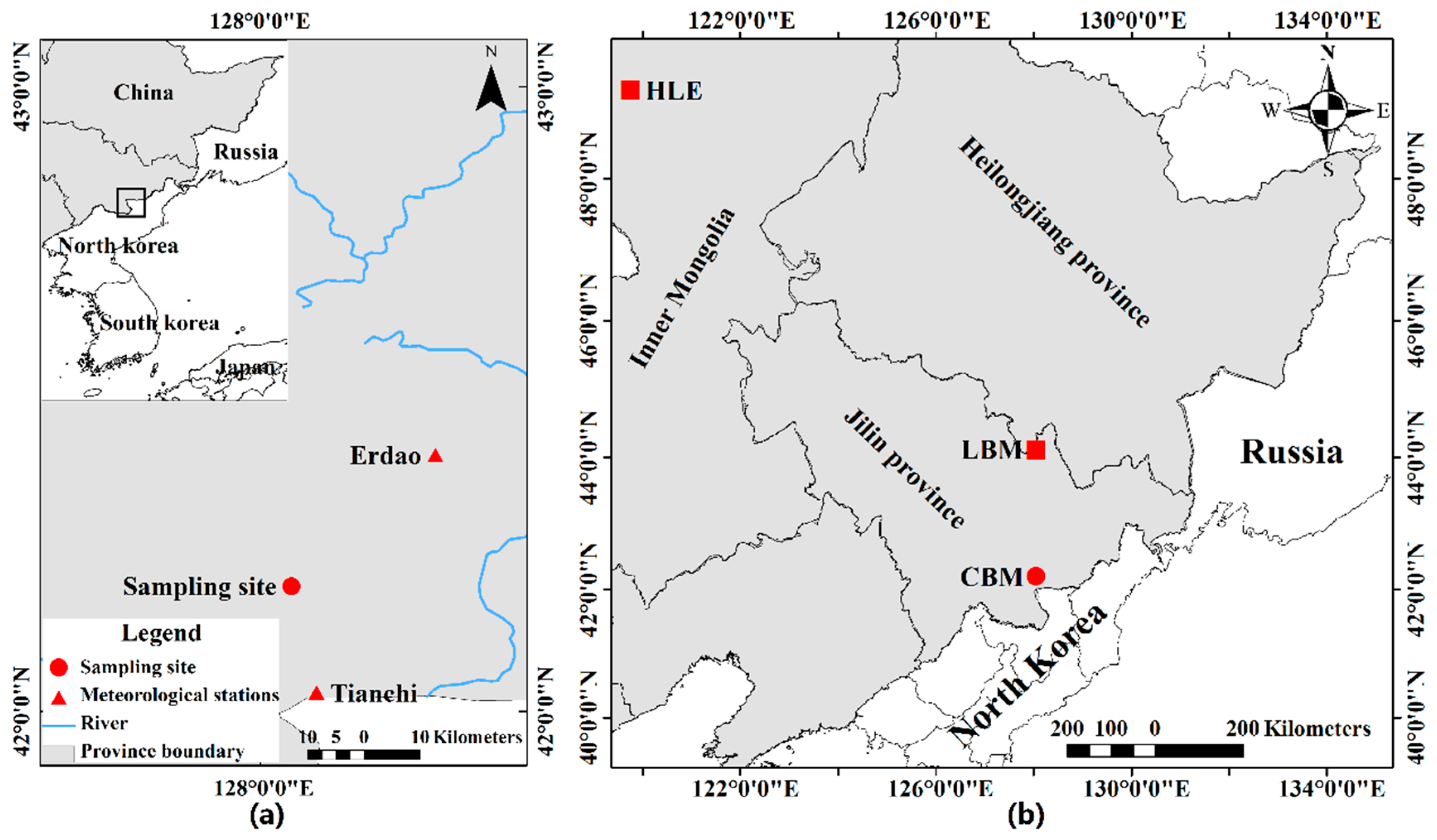
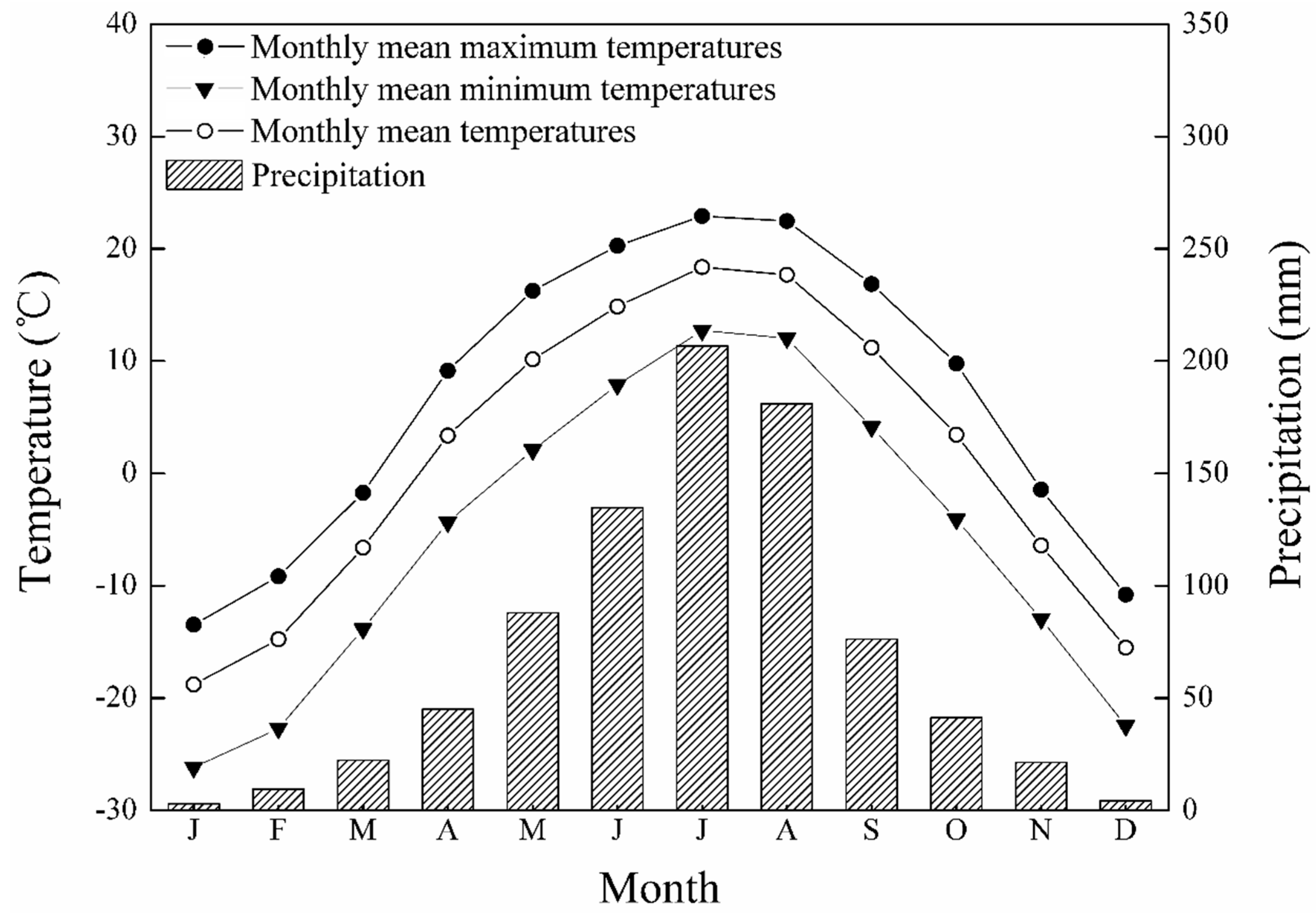
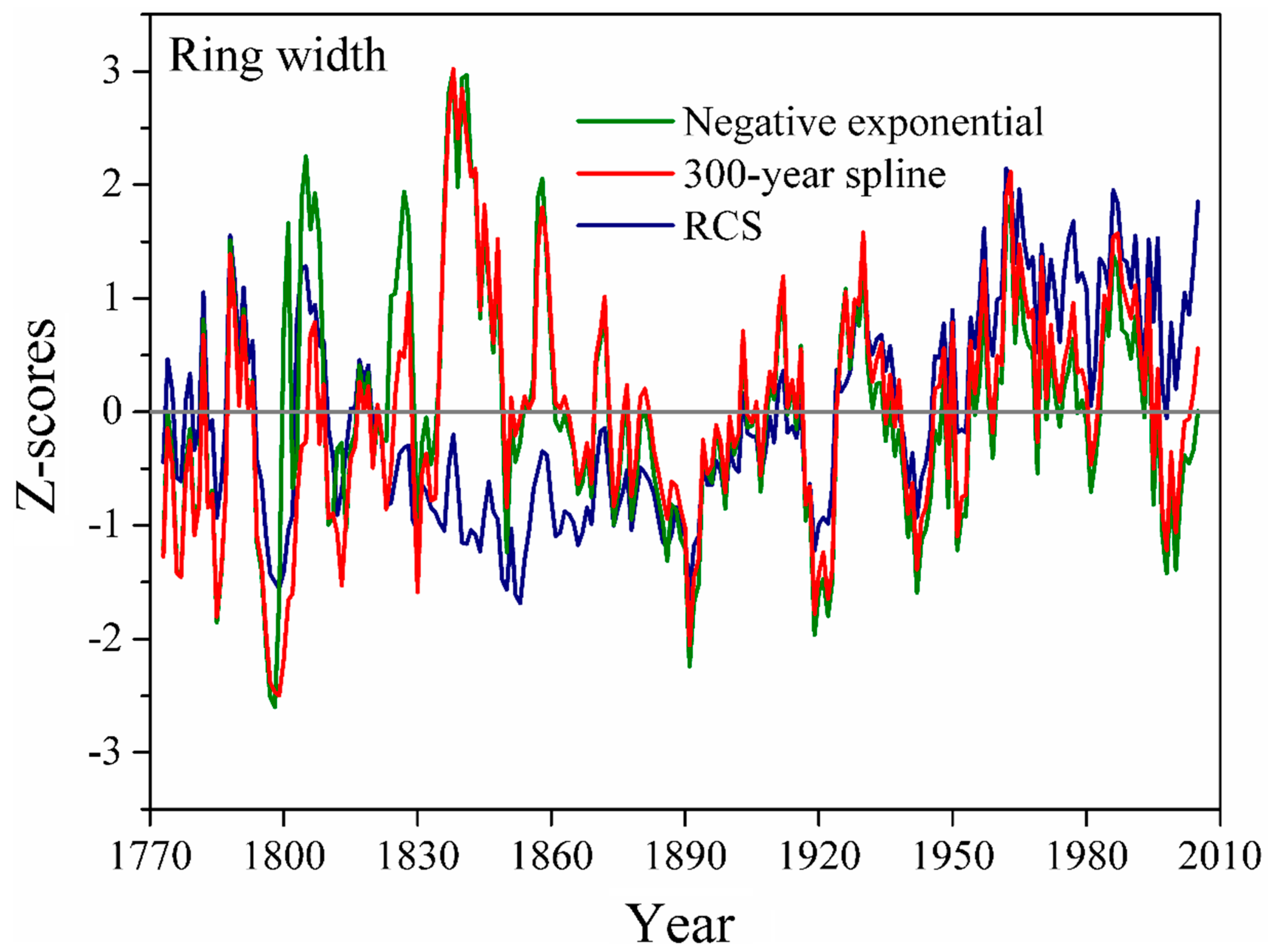
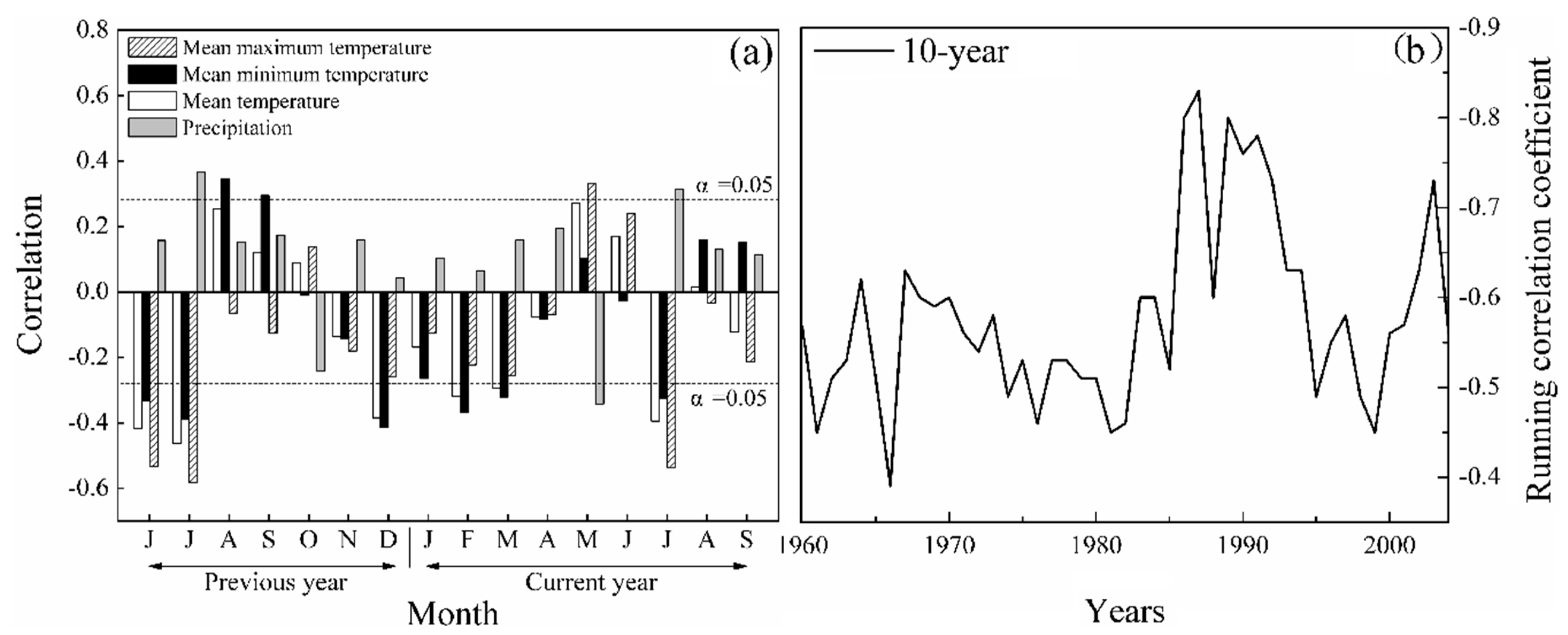
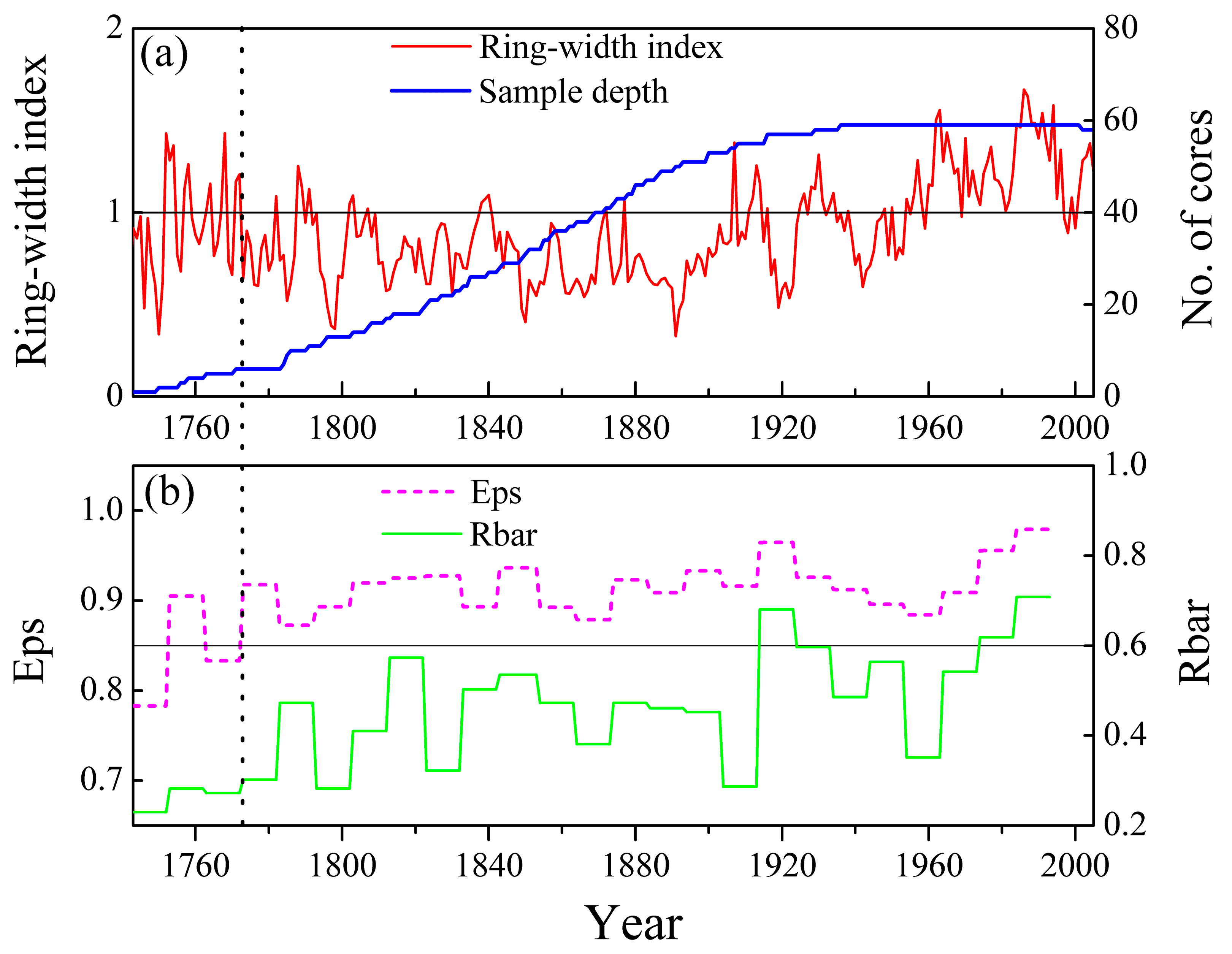
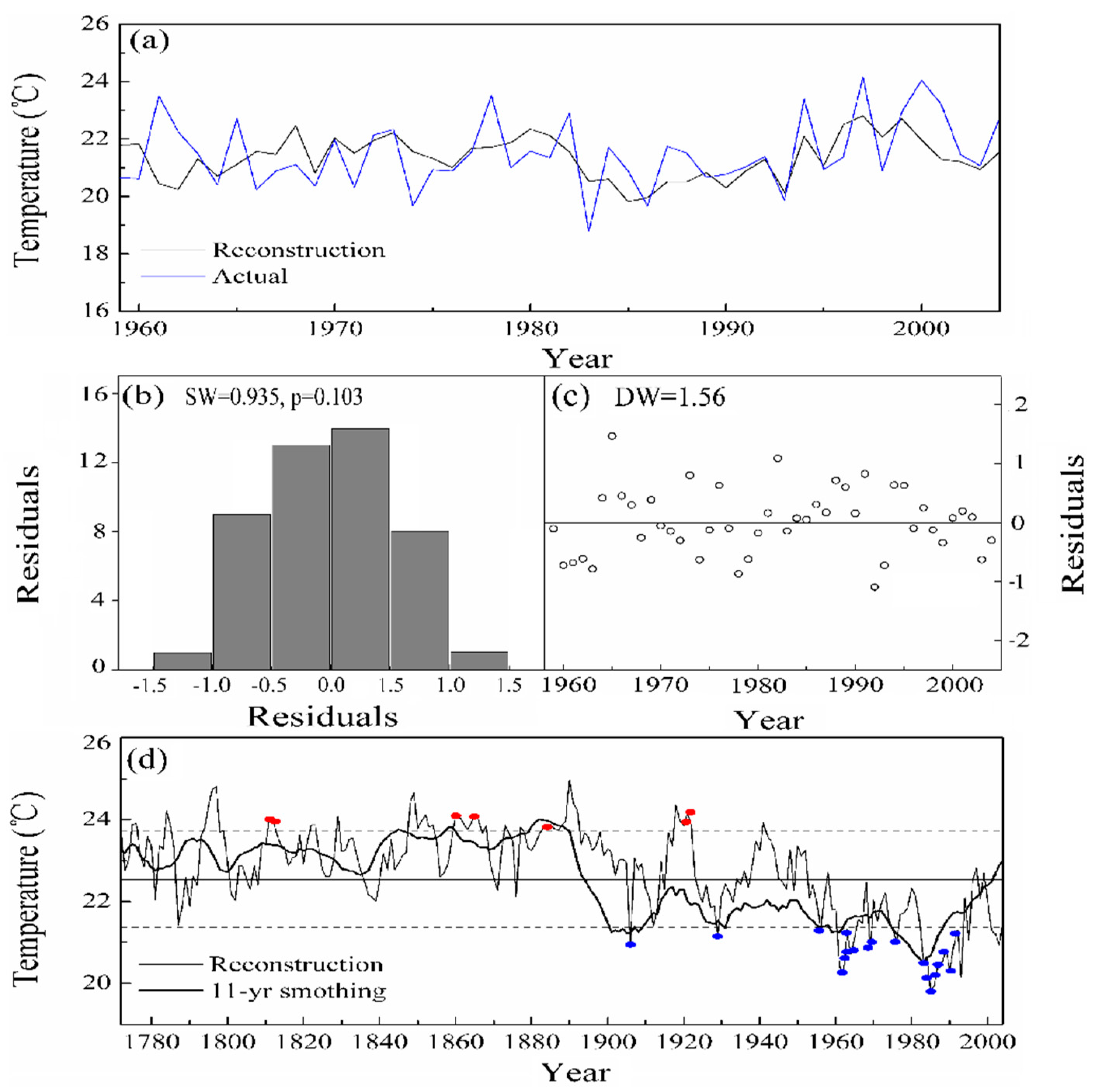
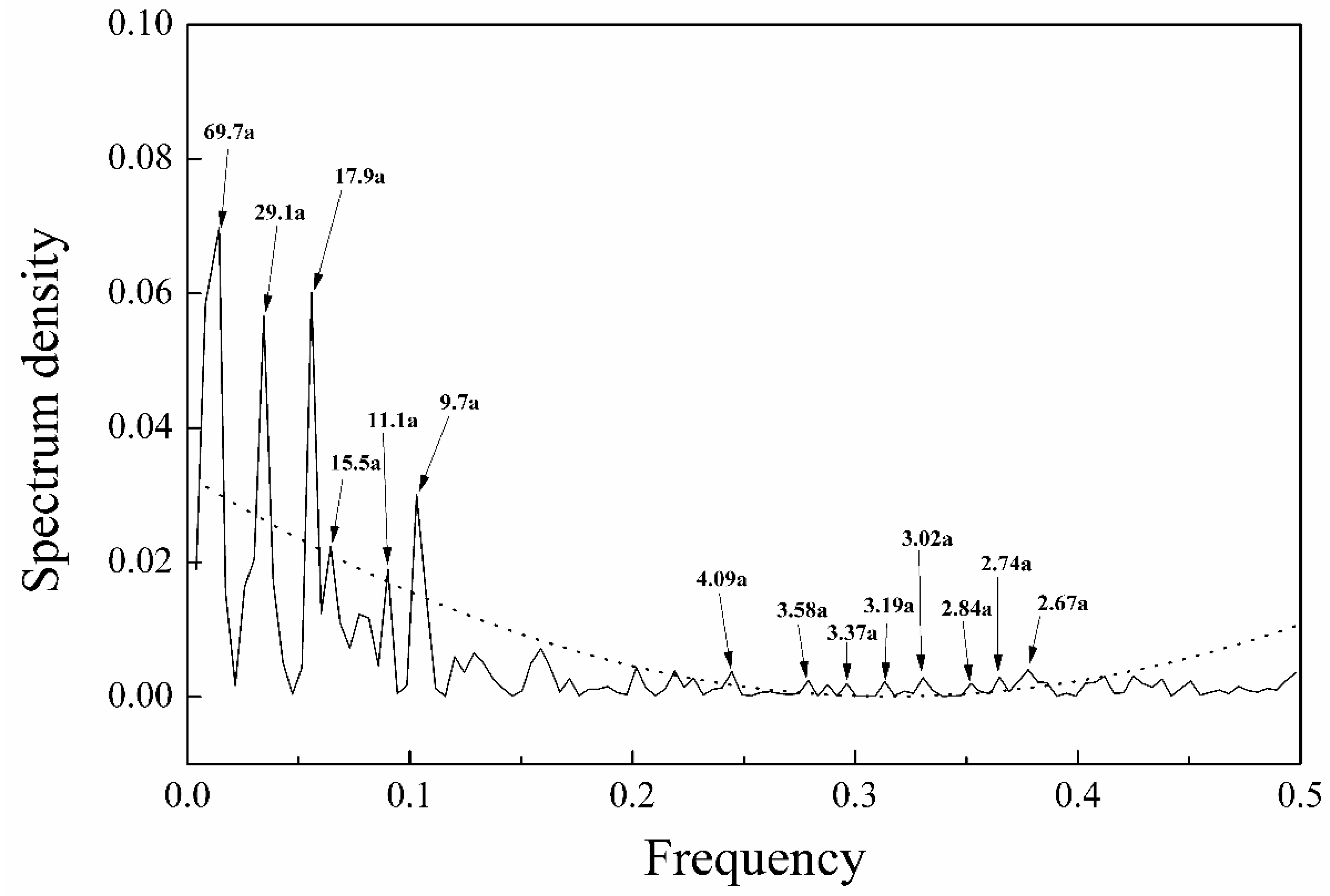
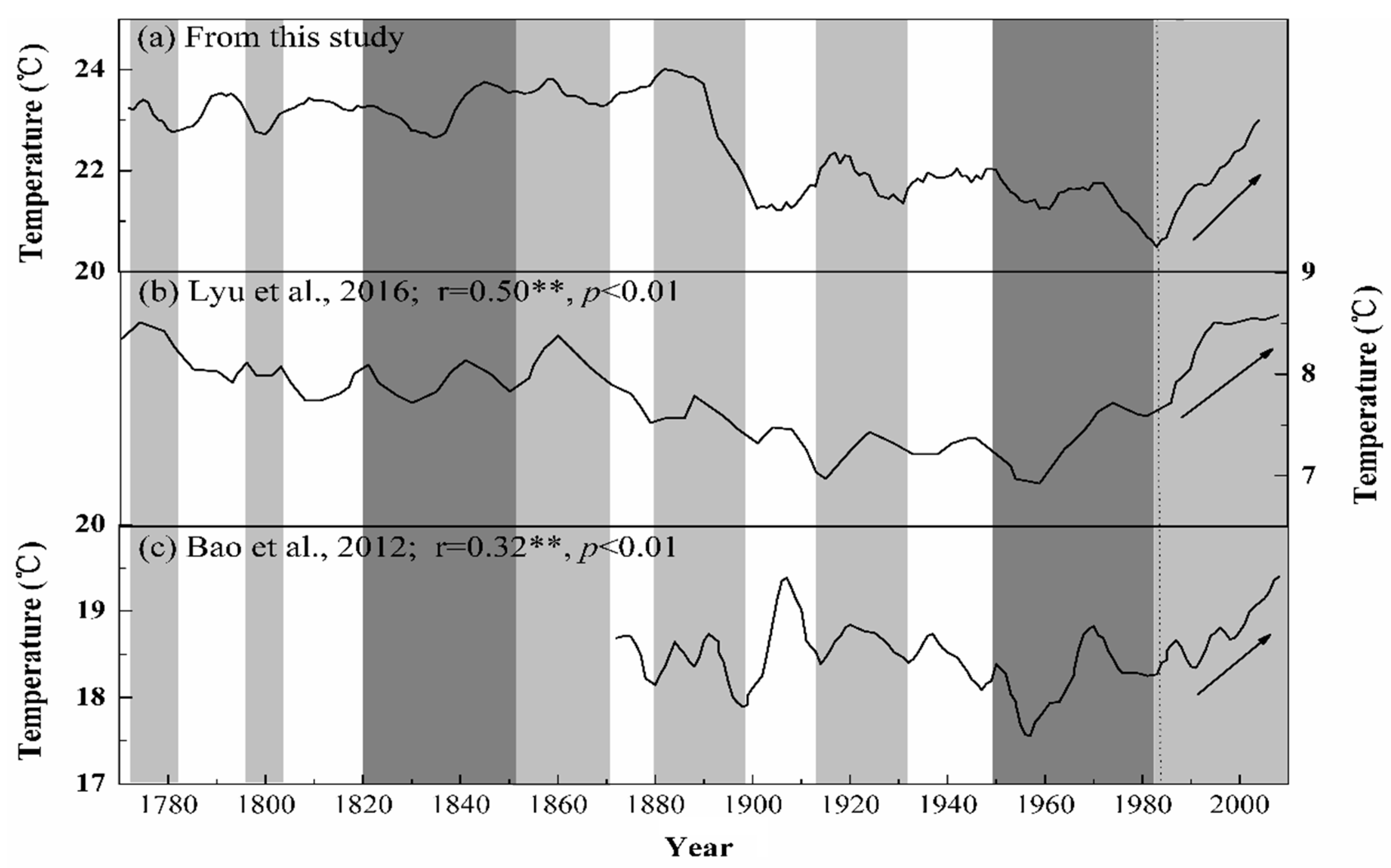
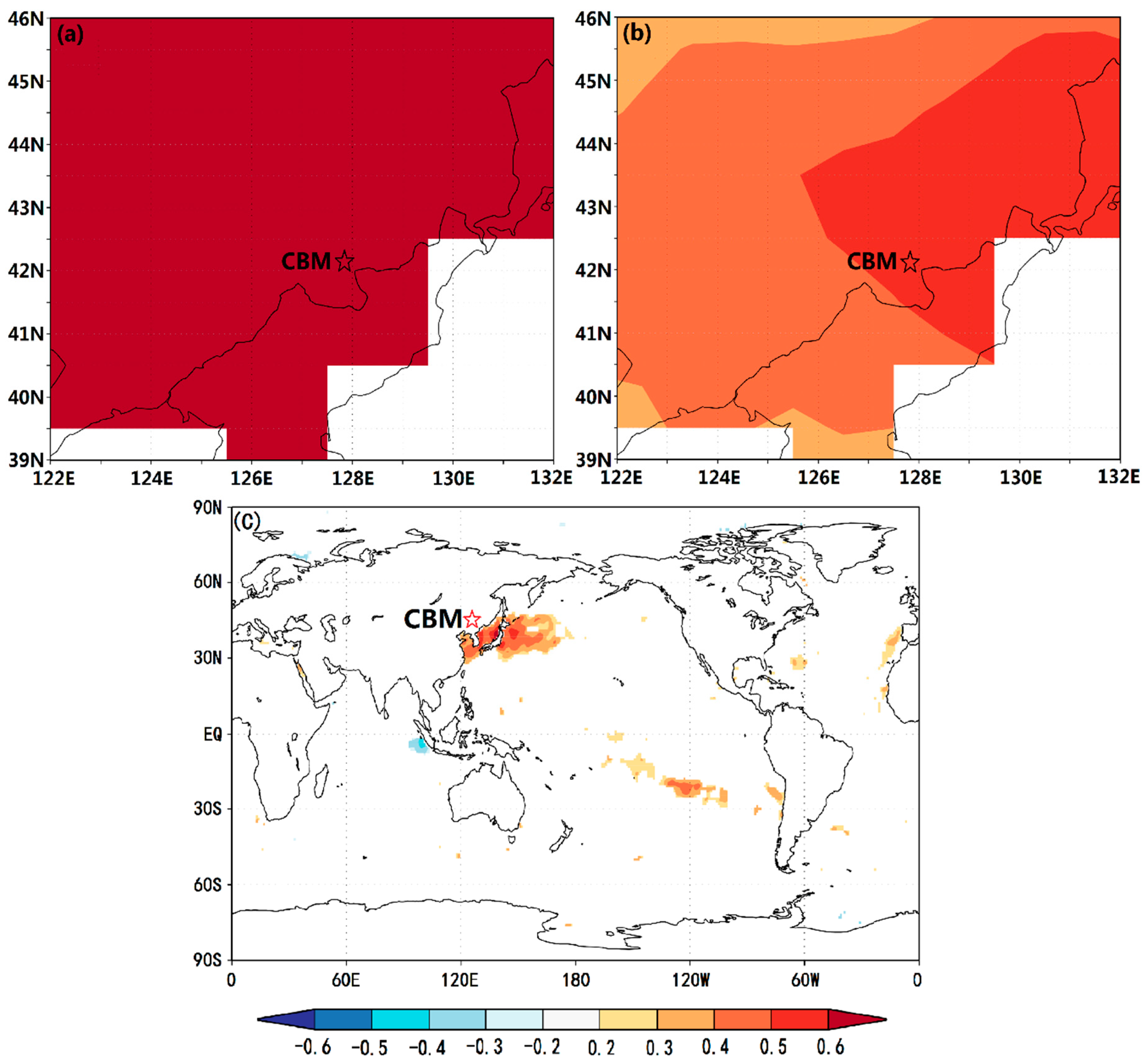
| Statistic | STD |
|---|---|
| MS | 0.32 |
| SD | 0.15 |
| Kurtosis | 0.17 |
| skewness | 0.45 |
| First order autocorrelation | 0.68 |
| Mean correlation between all series | 0.39 |
| Mean correlation between the trees | 0.35 |
| Mean correlation within a tree | 0.69 |
| Period | 1934/1743–2005 |
| SNR | 4.6 |
| MRW (mm) | 0.89 |
| EPS | 0.90 |
| First year where EPS > 0.85 (number of trees) | 1773 (6) |
| Months | Tmin | Tmean | Tmax |
|---|---|---|---|
| p6–p7 | −0.39 * | −0.45 * | −0.64 * |
| p8–p9 | 0.31 * | 0.17 | −0.12 |
| p12–c3 | −0.37 * | −0.31 * | −0.21 |
| p12–c2 | −0.35 * | −0.26 | −0.19 |
| p12–c1 | −0.29 | −0.25 | −0.16 |
| c1–c3 | −0.33 * | −0.31 * | −0.22 |
| c2–c3 | −0.36 * | −0.30 * | −0.27 |
| Parameter | Calibration | Verification | Calibration | Verification | Final Calibration |
|---|---|---|---|---|---|
| 1960–1982 | 1983–2005 | 1983–2005 | 1960–1982 | 1960–2005 | |
| r | −0.59 | −0.68 | −0.68 | −0.59 | −0.64 |
| R2 | 0.35 | 0.46 | 0.46 | 0.35 | 0.42 |
| R2adj | 0.34 | 0.44 | 0.41 | ||
| DW | 1.72 | 1.50 | 1.56 | ||
| RE | 0.35 | 0.46 | 0.46 | 0.31 | |
| CE | 0.35 | 0.41 | 0.46 | 0.22 | |
| t | 5.5 | 7.3 | 7.1 | 5.7 |
| Cold Period | Warm Period | |||||
|---|---|---|---|---|---|---|
| Rank | Period | Year | Mean (°C) | Period | Year | Mean (°C) |
| 1 | 1899–1913 | 15 | 21.41 | 1881–1888 | 9 | 23.93 |
| 2 | 1955–1970 | 16 | 21.49 | |||
| 3 | 1975–1989 | 15 | 20.97 | |||
© 2019 by the authors. Licensee MDPI, Basel, Switzerland. This article is an open access article distributed under the terms and conditions of the Creative Commons Attribution (CC BY) license (http://creativecommons.org/licenses/by/4.0/).
Share and Cite
Jiang, Y.; Yuan, X.; Zhang, J.; Han, S.; Chen, Z.; Wang, X.; Wang, J.; Hao, L.; Li, G.; Dong, S.; et al. Reconstruction of June–July Temperatures Based on a 233 Year Tree-Ring of Picea jezoensis var. microsperma. Forests 2019, 10, 416. https://doi.org/10.3390/f10050416
Jiang Y, Yuan X, Zhang J, Han S, Chen Z, Wang X, Wang J, Hao L, Li G, Dong S, et al. Reconstruction of June–July Temperatures Based on a 233 Year Tree-Ring of Picea jezoensis var. microsperma. Forests. 2019; 10(5):416. https://doi.org/10.3390/f10050416
Chicago/Turabian StyleJiang, Yangao, Xue Yuan, Junhui Zhang, Shijie Han, Zhenju Chen, Xiaoguang Wang, Junwei Wang, Lin Hao, Guode Li, Shengzhong Dong, and et al. 2019. "Reconstruction of June–July Temperatures Based on a 233 Year Tree-Ring of Picea jezoensis var. microsperma" Forests 10, no. 5: 416. https://doi.org/10.3390/f10050416
APA StyleJiang, Y., Yuan, X., Zhang, J., Han, S., Chen, Z., Wang, X., Wang, J., Hao, L., Li, G., Dong, S., & He, H. (2019). Reconstruction of June–July Temperatures Based on a 233 Year Tree-Ring of Picea jezoensis var. microsperma. Forests, 10(5), 416. https://doi.org/10.3390/f10050416




